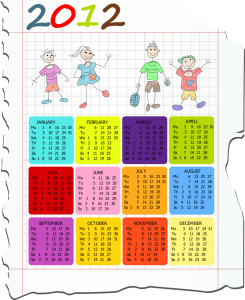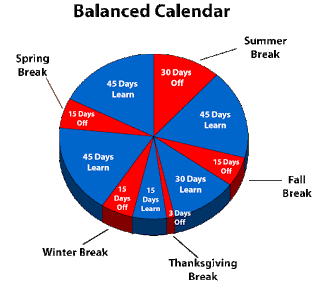 It’s July and summer is in full swing for many families: vacation, pool time, BBQs, beach trips, summer movies, keeping pests out of the garden (or is it just me?). But I was surprised when a Facebook teacher friend posted about going back to work this week, with students starting school on July 5th. Seriously? Summer has just begun! My curiosity got the best of me and I decided to do a little research.
It’s July and summer is in full swing for many families: vacation, pool time, BBQs, beach trips, summer movies, keeping pests out of the garden (or is it just me?). But I was surprised when a Facebook teacher friend posted about going back to work this week, with students starting school on July 5th. Seriously? Summer has just begun! My curiosity got the best of me and I decided to do a little research.First I confirmed that both calendar systems have 180 days of academic instruction. Year-round schedules can look very different depending on whether a school has multiple tracks or not. Both sides seem to have research and statistics to support their views, and support is strong for both.
An estimated 10% of American children now attend school year-round. I noticed a recent trend toward calling year-round a “balanced schedule,” and some school districts are now pushing for more than 180 days in the school year.
In summary, there appears to be very little difference in achievement between the two calendars overall, and most parents seem to be resigned to whatever system is in place locally. What do you think? Any preference?
Please leave your comments below. Here are some pros and cons of each for you to chew on:
Year-Round – Pros: (aka multi-track)
- 3-4 weeks off instead of 2-3 months = better skills retention
- breaks often land near traditional holidays when parents get time off from work
- short-term childcare often easier to find
- eliminates need for summer enrichment programs many families can’t afford
- more vacation options available for families
- multi-track system helps relieve overcrowding in schools
- remediation given at different times in academic year (intersession), giving more timely help to struggling students
- teacher and student stress lessened with regular breaks throughout the year
- may benefit achievement of disadvantaged students
Year-Round – Cons:
- teachers and students may have to switch classrooms during the year
- limited space availability makes remediation difficult in multi-track schools
- additional storage space needed for teachers who are off-track
- longer year and more demanding for custodians, cafeteria, maintenance, and administration
- parents may have difficulty scheduling childcare for multiple children
- limits time for teachers to update skills and earn advanced degrees
Traditional – Pros:
- it’s what most of us grew up with (read as: “people are afraid of change”)
- allows time for children to have authentic experiences outside of the classroom
- more summer camps and summer activities available to students
- more family time away from demands of school
- teachers get a real break from teaching and lesson planning
Traditional – Cons:
- nayre.org reports 2.6 months of learning lost during summer months (though there are plenty of reports that refute this claim)
- finding appropriate childcare can be difficult with many people going on vacation
- more time spent on review of previous year’s material at beginning of school year
- teachers get less time to reflect on teaching and students’ best learning styles
- remediation offered in summer is often too little, too late
Beaumont has a modified traditional schedule, which appears to be a compromise with less summer time off (7-8 weeks) and longer holiday breaks within the school year. My daughter gets plenty of time for camp, a family vacation, and some time to relax, read, and play her favorite computer games. And come the middle of August, I am ready for her to head back to school. Enough said.




